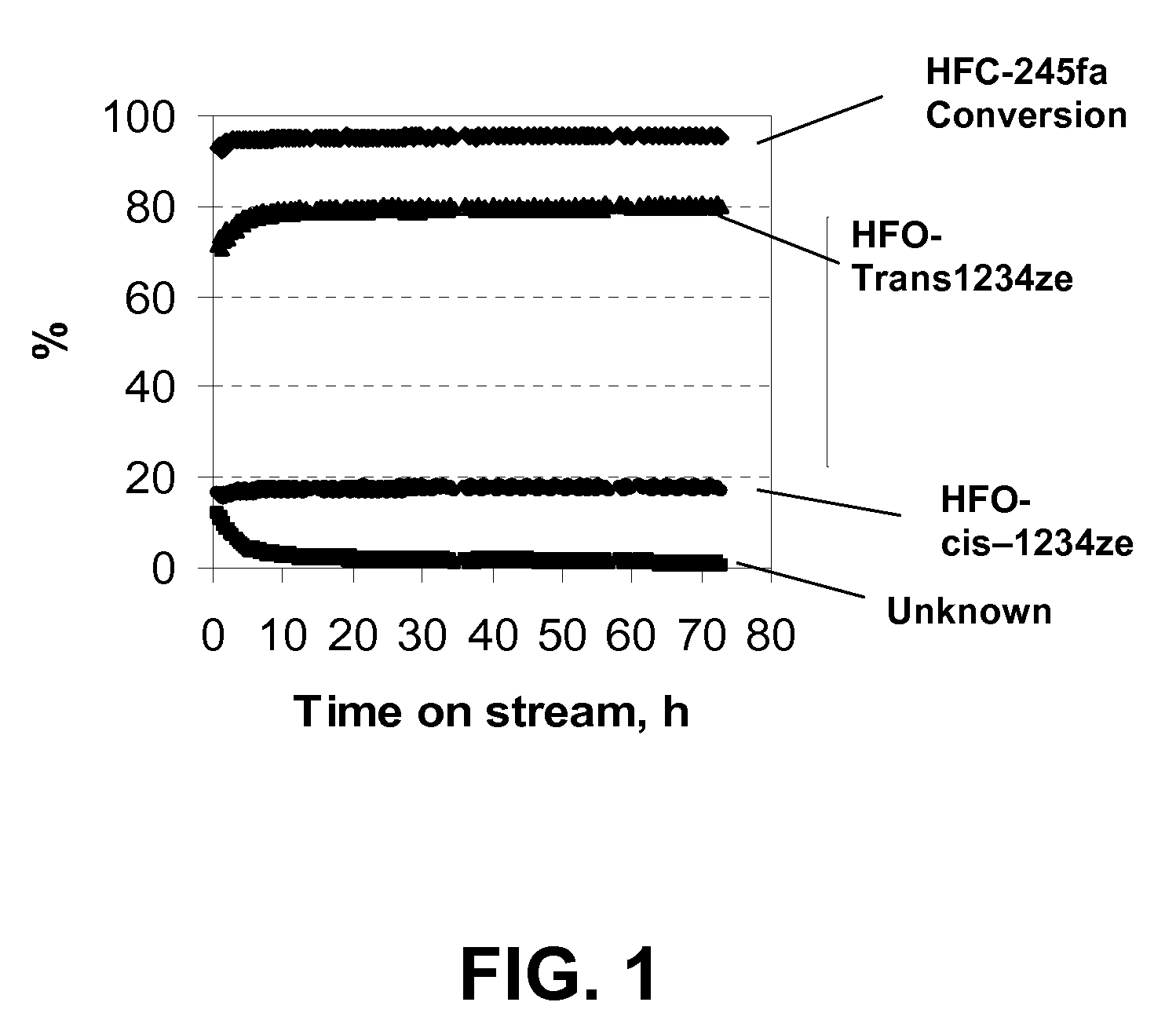PROCESS FOR THE PRODUCTION OF HFO TRANS-1234ze FROM HFC-245fa
a technology of hfo and hfc-245fa, which is applied in the field of process for the manufacture of hfo trans1234ze, can solve the problems of not being economical relative to the product yield of known processes, and certain chlorofluorocarbons might be detrimental to the earth's ozone layer
- Summary
- Abstract
- Description
- Claims
- Application Information
AI Technical Summary
Benefits of technology
Problems solved by technology
Method used
Image
Examples
example 1
HRC-245fa Dehydrofluorinaton Over Fluorinated Cr2O3 Catalyst
[0029]The catalyst used in this example was 20 cc of fluorined chromia catalyst (fluorinated Cr2O3). A >99% pure HFC-245fa feed was passed over this catalyst at a rate of 12 g / h at a temperature which ranged from 250° C. to 350° C. As shown in Table 1, with increasing reaction temperature from 250° C. to 350° C., the HFC-245fa conversion was increased from 65.2 to 96.0%, while the selectivity to trans-1234ze was slightly decreased from 84.7 to 80.6%. At 250° C., trans / cis-1234ze appeared to be the only products. As shown in FIG. 1, at 350° C., after an activation period of about 8 hours, the conversion of HFC-245fa and the selectivity to trans-1234ze remained at the same levels during the period of the study which lasted for 72 hours. These results indicate that the fluorinated Cr2O3 catalyst is very active and selective for converting 245fa to cis-1234ze and trans-1234ze and the catalyst has very high stability.
TABLE 1Effe...
example 2
HFC-245fa Dehydrofluorinaton Over Metal Fluoride Catalysts
[0030]The catalysts used in this example include three metal fluoride catalysts, namely, AlF3, FeF3, and 10% MgF2−90% AlF3. 20 cc of each catalyst was used during reaction. A >99% pure HFC-245fa feed was passed over each of the three catalysts at a rate of 12 g / hour at 350° C. As shown in Table 2, both AlF3 and 10% MgF2−90% AlF3 provided high activity (>95% HFC-245fa conversion) for HFC-245 dehydrofluorination, while FeF3 exhibited much lower activity (3 and 10% MgF2−90% AlF3 catalysts was about 80% at 350° C.
TABLE 2HFC-245fa dehydrofluorination over metal fluoride catalyststrans-trans-HFC-245fa1234zecis-1234zeunknown1234zeCatalystConversion %selectivity %selectivity %selectivity %lbs / hr / ft3AlF396.880.416.33.326.2FeF355.478.321.10.614.610% MgF2—90% AlF398.378.617.54.026.0
Reaction conditions: 20 cc catalyst, 12 g / h HFC-245fa, 350° C., 1 atm
example 3
HFC-245fa Dehydrofluorinaton Over Activated Carbon Supported Metal Catalysts
[0031]The catalysts used in Example 3 include three activated carbon supported metal catalysts, namely, 0.5 wt % Fe / AC, 0.5 wt % Ni / AC, and 5.0 wt % Co / AC. 20 cc of each catalyst was used during reaction. A >99% pure HFC-245fa feed was passed over each of the three catalysts at a rate of 12 g / h at 350° C. As shown in Table 3, among the activated carbon supported non-precious metal catalysts, iron exhibited the highest activity. At a reaction temperature of 525° C. the 0.5 wt % Fe / AC catalyst provided a cis / trans-1234ze selectivity of about 91% and a HFC-245fa conversion of about 80%.
TABLE 3HFC-245fa dehydrofluorination over activated carbon supported metalcatalysts at 525° C.trans-trans-HFC-245fa1234zecis-1234zeunknown1234zeCatalystConversion %selectivity %selectivity %selectivity %lbs / hr / ft30.5 wt % Fe / AC80.067.823.48.818.20.5 wt % Ni / AC24.846.616.636.83.95.0 wt % Co / AC10.920.17.272.70.7
PUM
| Property | Measurement | Unit |
|---|---|---|
| Temperature | aaaaa | aaaaa |
| Temperature | aaaaa | aaaaa |
| Time | aaaaa | aaaaa |
Abstract
Description
Claims
Application Information
 Login to View More
Login to View More - R&D
- Intellectual Property
- Life Sciences
- Materials
- Tech Scout
- Unparalleled Data Quality
- Higher Quality Content
- 60% Fewer Hallucinations
Browse by: Latest US Patents, China's latest patents, Technical Efficacy Thesaurus, Application Domain, Technology Topic, Popular Technical Reports.
© 2025 PatSnap. All rights reserved.Legal|Privacy policy|Modern Slavery Act Transparency Statement|Sitemap|About US| Contact US: help@patsnap.com


